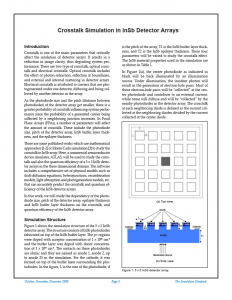Crosstalk Simulation in InSb Detector Arrays
Introduction
Crosstalk is one of the main parameters that critically affect the resolution of detector arrays. It results in a reduction in image clarity, thus degrading system performance. There are two type of crosstalk; optical crosstalk and electrical crosstalk. Optical crosstalk includes the effect of photon refraction, reflection at boundaries, and external and internal scattering in detector arrays. Electrical crosstalk is attributed to carriers that are photogenerated under one detector, diffusing and being collected by another detector in the array.
As the photodiode size and the pitch (distance between photodiodes) of the detector array get smaller, there is a greater probability of crosstalk influencing system performance since the probability of a generated carrier being collected by a neighboring junction increases. In Focal Plane Arrays (FPAs), a number of parameters will affect the amount of crosstalk. These include the photodiode size, pitch of the detector array, InSb buffer layer thickness, and the epilayer thickness.
There are some published works which use mathematical approaches [1-2] or Monte Carlo simulation [3] to study the crosstalk in InSb array. Here, a commercial semiconductor device simulator, ATLAS, will be used to study the crosstalk and also the quantum efficiency of a 5 x 5 InSb detector arrays in the three dimensional domain. The software includes a comprehensive set of physical models such as drift-diffusion equations, heterojunctions, recombination models, light absorption and photogeneration models, etc. that can accurately predict the crosstalk and quantum efficiency of the InSb detector arrays.
In this work, we will study the dependency of the photodiode size, pitch of the detector array, epilayer thickness and InSb buffer layer thickness on the crosstalk, and quantum efficiency of the InSb detector array.



